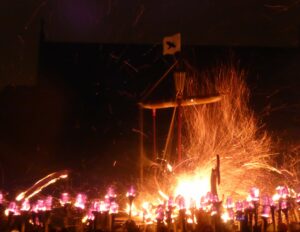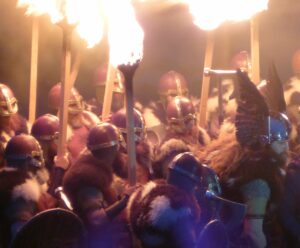
I woke to a panel discussion on Radio Scotland the other day regarding the current popularity of archaeology. It was nice to hear them praise the recent Orkney television series, but what really interested me was the link they made between living in uncertain times and the need to reinforce ideas of heritage.
At the end of January I travelled to Shetland to watch the annual Up Helly Aa fire festival. It was an amazing experience, and quite apart from letting my hair down, it got me thinking.
Up Helly Aa is possibly the most important date in the Shetland annual calendar. A local bank holiday, with a language and rituals all of its own. The protocol is important, and it is primarily enacted for islanders, though everyone goes out of their way to make sure that visitors have a good time. As a visitor, it is important to learn the ropes before the event takes place; there is plenty of advice regarding where to get food, what to wear and so on. Even, how not to offend your prospective dancing partners!
The core of the day harks back to Shetland’s Norse heritage as the Guiser Jarl, his Jarl Squad and galley, take over the town. Everywhere you look people are sporting helmets (with and without horns) and the schools and visitor centres use the opportunity to provide a crash course in the Vikings. But this is a recent festival with origins no further back than the early nineteenth century and the raucous Christmas and New Year celebrations at the time. Over time, the date has been shifted to the last Tuesday in January, the name Up Helly Aa introduced, and a general Viking theme adopted. Other disguises and acts are also incorporated as the festivities progress into the night.
This is a carefully curated and stage managed tradition. In Lerwick (the original Up Helly Aa) the protagonists are all men, though elsewhere across Shetland women join in and South Mainland even boasted a female Guiser Jarl in 2015. Yet, for all that, it is still a tradition. Judging by the events of 2017 it has a healthy and happy future for many years to come.
Shetland certainly had an important role as part of the Norse world. Viking sites are to be found all over the islands, from evocative homesteads, to semi-industrial soapstone quarries, merchants’ houses, and even the portage site at Mavis Grind. Those who participate in Up Helly Aa are choosing to reflect on those times and their importance in creating the islands of today. Does it matter that the tradition is a modern creation? There is, in fact, an interesting component of political satire, personal stereo-typing and cross dressing, which serves to keep activities well rooted in the twenty-first century. This is no romantic misty-eyed dreaming of the past. It is as up to date as any of us could hope to be.
Why do it?
Do we need a reason? It is certainly the most fun one can get in northern latitudes on a cold wet day in the middle of winter. Not only do you have fun – you can be someone else for the day.
At one level, it reinforces something that one does not have to spend long in Shetland at any time of year to experience. The expression of an identity that has little to do with mainland (or mainstream) Britain. These islands are nearer to Norway than they are to London and until the mid-fifteenth century they were part of the Danish kingdom. There is much in Shetland today that reminds one that the political origins here were Scandinavian.
At another level, we could return to my original question. Does the current popularity of Up Helly Aa, and the preponderance of knitted Viking Helmets in town, reflect the use of the happy security of times past in order to bolster morale in the uncertain days of the present? It seems counter-intuitive to use a period like the world of the Norse to provide emotional security. This was a time when people often lived in fear: a sail on the horizon could mean the arrival of a slaving ship; violent death was common; food supplies could be uncertain; and political unrest on a scale we have yet to experience in the UK today coloured the contemporary accounts of the time.

But, with that as the backdrop, life went on. Farms were farmed, fishermen fished, traders traded, and children grew into adults. Up Helly Aa may remind us of the daring-do, but within that we can hold on to ordinary life.
I have no doubt that Up Helly Aa will continue, troubled times or not, for many years to come. Ironically, the only cancellations have taken place during actual times of war and with the death of Queen Victoria. It is, for me, primarily a reinforcement of current identity. It is not meant to be authentically Norse, and who cares if the archaeological detail may, on occasion, be hazy. We all create our own pasts. This may be one of the most blatant and public expressions of the creation of the past, but it is by no means the only one. In a world that sometimes seems increasingly anodyne and uniform, such diversity is to be welcomed and nurtured.
You must be logged in to post a comment.